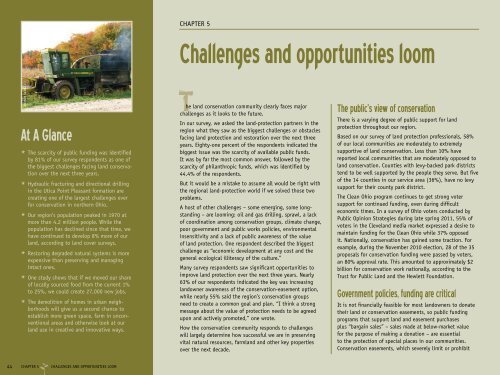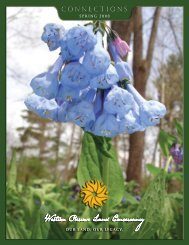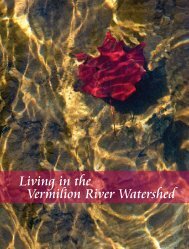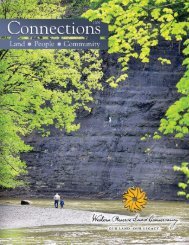Common Ground - Western Reserve Land Conservancy
Common Ground - Western Reserve Land Conservancy
Common Ground - Western Reserve Land Conservancy
Create successful ePaper yourself
Turn your PDF publications into a flip-book with our unique Google optimized e-Paper software.
At A Glance<br />
* The scarcity of public funding was identified<br />
* Hydraulic fracturing and directional drilling<br />
* Our region’s population peaked in 1970 at<br />
* Restoring degraded natural systems is more<br />
* One study shows that if we moved our share<br />
* The demolition of homes in urban neigh-<br />
by 81% of our survey respondents as one of<br />
the biggest challenges facing land conservation<br />
over the next three years.<br />
in the Utica Point Pleasant formation are<br />
creating one of the largest challenges ever<br />
for conservation in northern Ohio.<br />
more than 4.2 million people. While the<br />
population has declined since that time, we<br />
have continued to develop 8% more of our<br />
land, according to land cover surveys.<br />
expensive than preserving and managing<br />
intact ones.<br />
of locally sourced food from the current 1%<br />
to 25%, we could create 27,000 new jobs.<br />
borhoods will give us a second chance to<br />
establish more green space, farm in unconventional<br />
areas and otherwise look at our<br />
land use in creative and innovative ways.<br />
44 CHAPTER 5 CHALLENGES AND OPPORTUNITIES LOOM<br />
CHAPTER 5<br />
Challenges and opportunities loom<br />
T he land conservation community clearly faces major<br />
challenges as it looks to the future.<br />
In our survey, we asked the land-protection partners in the<br />
region what they saw as the biggest challenges or obstacles<br />
facing land protection and restoration over the next three<br />
years. Eighty-one percent of the respondents indicated the<br />
biggest issue was the scarcity of available public funds.<br />
It was by far the most common answer, followed by the<br />
scarcity of philanthropic funds, which was identified by<br />
44.4% of the respondents.<br />
But it would be a mistake to assume all would be right with<br />
the regional land-protection world if we solved those two<br />
problems.<br />
A host of other challenges – some emerging, some longstanding<br />
– are looming: oil and gas drilling, sprawl, a lack<br />
of coordination among conservation groups, climate change,<br />
poor government and public works policies, environmental<br />
insensitivity and a lack of public awareness of the value<br />
of land protection. One respondent described the biggest<br />
challenge as “economic development at any cost and the<br />
general ecological illiteracy of the culture.”<br />
Many survey respondents saw significant opportunities to<br />
improve land protection over the next three years. Nearly<br />
63% of our respondents indicated the key was increasing<br />
landowner awareness of the conservation-easement option,<br />
while nearly 55% said the region’s conservation groups<br />
need to create a common goal and plan. “I think a strong<br />
message about the value of protection needs to be agreed<br />
upon and actively promoted,” one wrote.<br />
How the conservation community responds to challenges<br />
will largely determine how successful we are in preserving<br />
vital natural resources, farmland and other key properties<br />
over the next decade.<br />
The public’s view of conservation<br />
There is a varying degree of public support for land<br />
protection throughout our region.<br />
Based on our survey of land protection professionals, 58%<br />
of our local communities are moderately to extremely<br />
supportive of land conservation. Less than 10% have<br />
reported local communities that are moderately opposed to<br />
land conservation. Counties with levy-backed park districts<br />
tend to be well supported by the people they serve. But five<br />
of the 14 counties in our service area (36%), have no levy<br />
support for their county park district.<br />
The Clean Ohio program continues to get strong voter<br />
support for continued funding, even during difficult<br />
economic times. In a survey of Ohio voters conducted by<br />
Public Opinion Strategies during late spring 2011, 55% of<br />
voters in the Cleveland media market expressed a desire to<br />
maintain funding for the Clean Ohio while 37% opposed<br />
it. Nationally, conservation has gained some traction. For<br />
example, during the November 2010 election, 28 of the 35<br />
proposals for conservation funding were passed by voters,<br />
an 80% approval rate. This amounted to approximately $2<br />
billion for conservation work nationally, according to the<br />
Trust for Public <strong>Land</strong> and the Hewlett Foundation.<br />
Government policies, funding are critical<br />
It is not financially feasible for most landowners to donate<br />
their land or conservation easements, so public funding<br />
programs that support land and easement purchases<br />
plus “bargain sales” – sales made at below-market value<br />
for the purpose of making a donation – are essential<br />
to the protection of special places in our communities.<br />
Conservation easements, which severely limit or prohibit









